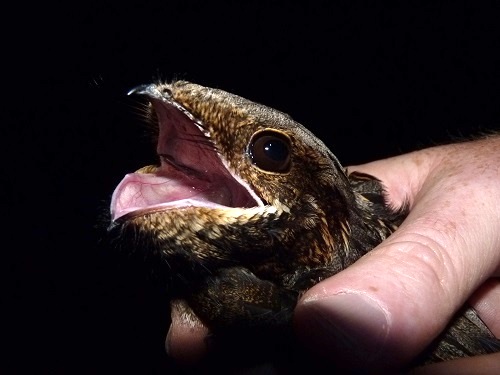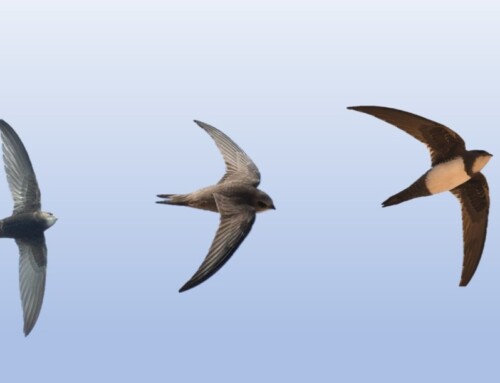LINKED PAPER
Home-range size and habitat use of European Nightjars Caprimulgus europaeus nesting in a complex plantation-forest landscape.
Katrina Sharps, Ian Henderson, Greg Conway, Neal Armour-Chelu & Paul M. Dolman.
IBIS. DOI: 10.1111/ibi.12251
In Europe, commercially managed forest can provide important habitat for birds of conservation concern. However, knowledge of avian responses to forest management is lacking. We investigated the foraging habits of a unique, sometimes mysterious bird nesting in pine plantation forest in the UK and provide management recommendations for the benefit of this species.
The European Nightjar Caprimulgus europaeus can be a tricky species to study. Often, the male Nightjar’s unique churring call is the only sign that these migrants have arrived in the UK for the summer, unless you are lucky enough to see one silhouetted against the moonlight. This is a species associated with myths and legends. In many European languages, the Nightjar is known as the ‘goatsucker,’ with the genus name Caprimulgus deriving from the Latin for ‘milker of goats’. It was believed that Nightjars fed from goats due to often being found in close proximity to livestock. In reality, this insectivorous species would have been searching for prey associated with domestic animals. Others believed the calls of the Nightjar were the sound of witches hiding in the bushes.

Traditionally a heathland species, the European Nightjar can also be found nesting in pine plantation with sparse tree cover. Between 1972 and 1992, the Nightjar range in the UK declined by >50% (Gregory et al. 2002), primarily due to habitat loss. Subsequently the Nightjar is a Species of European Conservation Concern (SPEC 2) and protected under Annex 1 of the EU ‘Birds’ Directive (Directive on the conservation of wild birds79/409/EEC). In recent years, there has been an overall increase in Nightjar population number in the UK due to habitat restoration but the range is not recovering at the same rate and there are still localised declines in some parts of the country (Conway et al. 2007).
The Nightjar can fly long distances to feed, with birds recorded foraging up to 6km from the nest site (Alexander & Cresswell 1990). Nightjars nesting in plantation forest have been found feeding in a variety of habitats including deciduous woodland, open oak scrubland, young conifer plantations and heathland. We wanted to discover more about the factors driving Nightjar foraging habitat selection in plantation forest. Are Nightjars regularly leaving the forest to feed? In order to follow this secretive species on their feeding trips, we caught and radio-tagged 31 birds in Thetford Forest, the largest lowland commercial forest in the UK, found to hold ~10% of the UK Nightjar population during the last national survey (Conway et al. 2007). As the forest is managed by clear-felling, it consists of a mosaic of growth stages. There are also patches of heathland within and adjacent to the forest, amidst surrounding arable land.
From May to the end of August (2009/10), our field teams tracked the tagged birds from dusk until dawn. Nocturnal fieldwork can be challenging, however I was lucky to have an enthusiastic Nightjar tracking team. Additionally, working overnight in a UK forest during the summer can have advantages, namely, experiencing countless colourful sunsets and sunrises, watching young fawns bouncing through the grass at dawn, and listening out for Woodcock Scolopax rusticola flying overhead, or the distinctive song of the Woodlark Lullula arborea.
Radio-tracking for European Nightjars © Vivien Hartwell
The information that we gathered was used to map song territories and home ranges for paired and unpaired males and female birds. Distances travelled between roost and nest sites to foraging locations were also calculated. We discovered that Nightjar home ranges (for females, paired males and unpaired males) were an order of magnitude larger than the song territories of paired males, emphasising the importance of habitat outside the territory. Birds travelled a mean maximum distance of 747m from the centre of the territory every night, which is lower than that recorded for other Nightjar populations.
Using compositional analysis (Aebischer et al. 1993) to investigate foraging habitat use, we found that pre-closure canopy forest (5-10 years) and newly planted forest (0-5 years) were important habitats for the birds. Grazed grass heathland was also selected, but only when telemetry fixes were compared to habitat composition within 2km of the territory centre. Ungrazed heathland was not selected. Results suggest that the structure of the forest may influence the extent to which Nightjars leave the forest to forage. Nightjars nesting in densely planted forest of uniform age have been recorded regularly leaving the forest to feed (Alexander & Cresswell 1990), in contrast to the birds nesting amongst the mixed-age growth stages of Thetford Forest. Grazed heathland may provide further foraging opportunities, for example, dung beetles associated with livestock, while the denser, ungrazed heathland may be difficult to feed in.
During our two year investigation, we used a number of other techniques to piece together a clear picture of the foraging requirements of Nightjars nesting within managed plantation forest, including moth trapping. Moths are a key component of the Nightjar diet (Cramp 1985, Sharps 2013) and we were interested to find out if Nightjars were foraging in the habitats with the greatest moth biomass. Using actinic moth traps (which have a relatively small attraction radius), we caught a wonderful variety of moths, including elephant hawkmoth Deilephila elpenor, fluffy drinker moth Euthrix potatoria, and buff-tip Phalera bucephala, perfectly camouflaged to look like a twig.
Buff-tip moth © Vivien Hartwell
Interestingly, our study showed that the highest moth biomass tended to be in the older stands of forest, despite Nightjars tending to forage in the more open, younger forest stands. This may be because the thick, dense tree foliage within the older stands makes it harder for birds to navigate and search for prey, as has been suggested by Sierro et al. (2001).
Using radiotracking, we have delved into the foraging habits of this secretive species. Our study demonstrates that the management of commercial pine plantation forest can have important implications for this species of conservation concern. The combination of mixed-age plantation forest with patches of heathland can provide both nesting and foraging habitat for the European Nightjar, reducing the need for birds to leave the forest and fly long distances to reach suitable foraging habitat.
References and further reading
Aebischer, N.J., Robertson, P.A. & Kenward, R.E. 1993. Compositional analysis of habitat use from animal radio-tracking data. Ecology 74: 1313–1325. View
Alexander, I. & Cresswell, B. 1990. Foraging by Nightjars Caprimulgus europaeus away from their nesting areas. Ibis 132: 568–574. View
Conway, G., Wotton, S., Henderson, I., Langston, R., Drewitt, A. & Currie, F. 2007. Status and distribution of European Nightjars Caprimulgus europaeus in the UK in 2004. Bird Study 54: 98–111. View
Cramp, S. (ed.) 1985. The Birds of the Western Paleartic, Vol 4. Oxford: Oxford University Press.
Gregory, R.D., Wilkinson, N.I., Noble, D.G., Robinson, J.A.,Brown, A.F., Hughes, J., Procter, D.A., Gibbons, D.W. & Galbraith, C.A. 2002. The population status of birds in the United Kingdom, Channel Islands and Isle of Man: an analysis of conservation concern 2002–2007. Br. Birds 95: 410–450. View
Sharps, K. 2013. The conservation ecology of the European Nightjar (Caprimulgus europaeus) in a complex heathland-plantation landscape. PhD thesis, University of East Anglia, Norwich, UK. View
Sierro, A., Arlettaz, R., Naef-Daenzer, B., Strebel, S. & Zbinden, N. 2001. Habitat use and foraging ecology of the nightjar (Caprimulgus europaeus) in the Swiss Alps: towards a conservation scheme. Biol. Conserv. 98: 325–331. View






